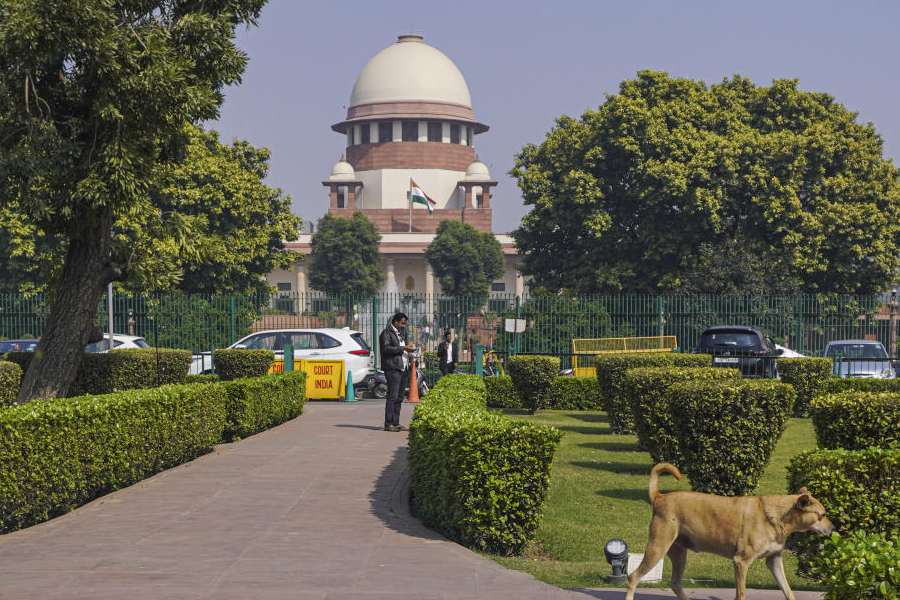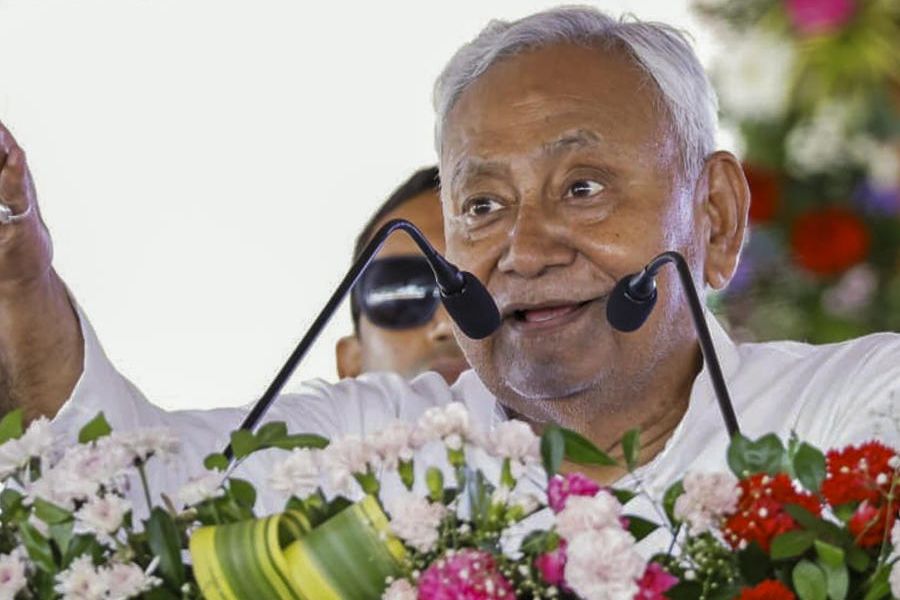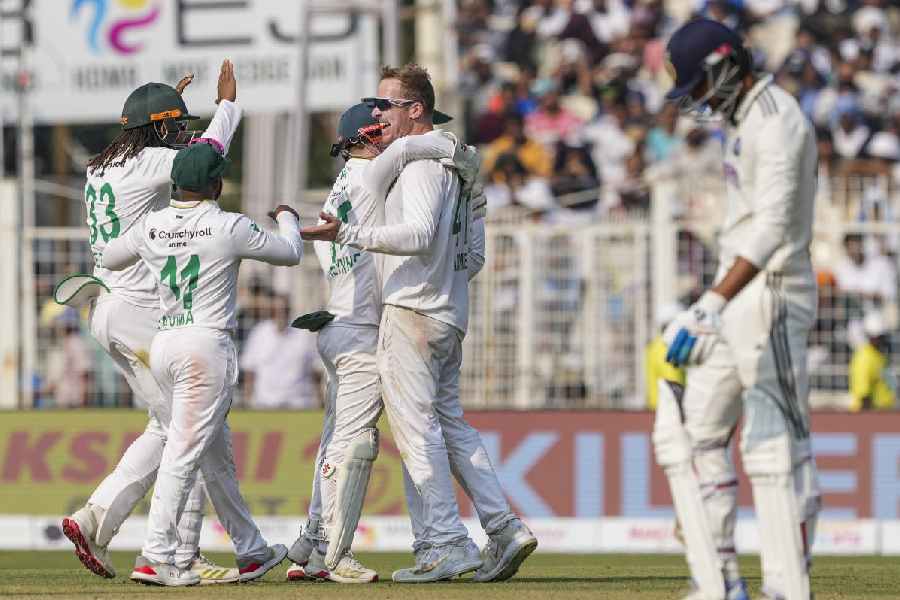
Saint Teresa... That makes you somewhat distant, Mother Teresa. It places you, warm, vital, restless, in a cold glass case with wax candles all around you. Sainthood turns you, the owner of a thousand wrinkles, into a doll of the smoothest plaster. It turns you, a woman with the brow of care on your forehead, into a caramel éclair.
Popular reckoning says the Catholic world has had, roughly, 10,000 saints, each of them with a set smile, a fixed halo, hands raised in everlasting blessing. These come from 'back then', from the early days of Christianity. Of the 'properly' canonized ones, that is, those who have been so titled by the Pope, a more exact number is given - 810. And so, Ma Teresa, you are now moving the Vatican 810 to the fine count of 811 and the 10,000 to a rough 10,000 and more.
You never heard Earl Grant's Number Fifty Four, did you? No matter. Let me rejig it for you to say that as a saint you now make
A full 10K 'n more/
In a waxen case/
With a waxen roof a waxen base/
- Don't turn a waxen bore!
Now that you are a saint you will wear a halo of wax sticks and you will shed, in public view, viscous tears. "Whoa!" they will exclaim, "A miracle!" And the multitudes will throng. From Skopje, where you were born, to Calcutta where you died, from Brasília to Manila, the 2.4 billion Christians the world over (33 per cent of its population, no less), of which around 1.27 billion are Roman Catholics (17.8 per cent) and non-Christians no less, will crowd centres of your Missionaries of Charity and seeing the cracks on your waxen images will shout: "See her veins, her throbbing veins! She is alive, the Saint! Saint Teresa lives!" Grown-ups mimic their grandchildren.
But seeing it 'all in all', let me say, Ma Teresa, that your canonization is a wonderful thing to be happening, particularly now. The scholar-priest, Reverend Father Adrian Mascarenhas, has put it thus: "The significance of the canonisation is that St. Teresa stands for a Church that is spontaneous in its response to human suffering - a message that is also close to the heart of Pope Francis - a Church that acts, that intervenes, that gets involved, without asking questions or making distinctions, a Church that is basically on a rescue mission to those whose lives have been shattered."
I value your canonization for that, Ma, and for these three supplementary reasons: first, it has brought to our forgetful society a new awareness of your incredible life. Second, it has brought a new attention to Christian India. Third, it has given a pause, brief though it may be, to the tsunami of majoritarianism overtaking our country.
To focus on the first reason first, you remember the day you were driven up the capacious forecourt of the Rashtrapati Bhavan where India's First Citizen resides? You emerged from the car, almost weightless, smiling through those creases on your face, looked with a practical gaze at the presidential palace, and said: "This building will do nicely for our work." Mother Teresa, going to be beatified, to become a saint, you were also a woman who had a certain job as well, albeit honorary - that of a space manager - so many sick to so many square feet, so many cribs to not so many square feet. You were a working woman with children to look after, old children and small children, with little money and less time. You were the very personification of millions of overworked and under-acknowledged mothers.
Now, for the second reason for celebration.
Your canonization gives India the chance to deepen its knowledge of Christian India. Your becoming a saint should bring back to our collective mind the fact that but for that emancipator of India's womanhood, Raja Rammohan Roy (1772-1833), powerfully influenced by Christianity, India would have been burning widows, including little 'widowed' girls for another two centuries. The Raja was from our East. From our West, Pandita Ramabai (1858-1922), the Sanskritist and Christian, showed that India's girl-child was brighter than the lout who claimed superiority over her, and so she must go to school, college, become a harbinger of change. From our Tamil south, the Kumarappa brothers, J.C. (1892-1960) and Bharatan (1896-1957), provided the much-needed intellectual leavening to the movement for swaraj, even as in Kerala, George Joseph (1887-1938) led the freedom struggle there with inspirational grit, while Mangalore-born Reverend Jerome D'Souza (1897-1977), Jesuit priest, impacted the thought processes of our Constituent Assembly transformationally.
"Don't leave out the North," you will point out, Ma, and you will be right. I almost did, but that is because the North tends, despite itself, to dominate and I dislike domination. Amrit Kaur, brave rajkumari of Kapurthala (1889-1964), as a woman, a Christian and a Sikh-Christian at that, personified resistance as a freedom-fighter, modernization as an educationist and was India's first health minister. She it was who inaugurated mass immunization and family planning in our society controlled by superstition and quackery.
You never dabbled in statistics Ma. "Numbers?" you may well say. "The only numbers I know are of the dying." But we need to know that there are 27.8 million Christians in India (1.16 per cent of the world's Christians, and around 2.3 per cent of the population of India). Of these, 17.3 million are Catholics (around 1.4 per cent of the world's Catholics, or 1.55 per cent of the population of India).
Christianity has spurred education with Anglo-Indians in the lead, bolstered medical care with missions driving it, as few others have. In 1869, when Wellesley Bailey, a young Irish teacher in Punjab, saw a row of huts inhabited by persons with serious deformities. Shocked to learn that they were suffering from leprosy, Bailey was to recall: "I almost shuddered, yet I was at the same time fascinated, and I felt that if there was ever a Christlike work in the world it was to go amongst these poor sufferers and bring them the consolation of the gospel." That was the beginning of The Leprosy Mission in India. Ida Scudder, Graham and Gladys Staines have carried the work further afield, with other pioneers, many of them non-Christian, doing the same.
What about conversions? Were they not awful things to have happened? Done through intimidation and exploitation, of course they were. You have not escaped the charge yourself, Ma, have you? Did you, while ministering to the leprosy-hit, put a wafer and wine to her or his lips and say, "Ayesha, you are now Alice", or "Biman, you are now Basil"? If you did, a thousand pities. But if you did not, shame, a thousand shames, on the accuser for he was doing precious little for Ayesha or for Biman.
Missionaries may have made our Northeast a strong home to Christianity; they have thereby also made India's Northeast that much more at home with India, its 'India-ness', which is so different from Brahminic Bharatiyata or Delhi-centric Hindustaniyat. Conversions are a sorry fact but they belong, in most part, to history. Tendentious non-Christian reviling of Christian conversions is a sorrier fact for it belongs wholly to political opportunism.
'Rainbow nation' is a phrase that belongs to Mandela's South Africa, but if India has tones of many hues in many ways, one has come from non-Indians domiciled here. Despondent India met a counsellor in C.F. Andrews, tribal India a friend in Verrier Elwin, and, above all others, in you, Ma Teresa, destitute India found a redeemer. If all these could come to serve India, we have Jesus Christ to thank.
What of 'the idea of India'? you may ask, saying those words, now so over-used, with some scepticism, which brings me to the third reason for celebrating your canonization. Jerome D'Souza, that handsome Mangalorean, as a member of the Constituent Assembly, strove for the rights of the minorities to be protected by the Constitution. He was instrumental, along with Harendra C. Mookerjee (1887-1956), who chaired the minorities sub-committee of the Constituent Assembly, in having the right to practise and propagate one's religion included in the Constitution as a fundamental right. Nehru made D'Souza join India's delegations to the general assembly of the United Nations four times.
That was then. We are in the 'now'.
Only the other day, the president of the Bharatiya Janata Party said in Jerome D'Souza's Mangalore: "It has become a fashion for persons and organisations to question nationalism by invoking their right to freedom of expression." And he then told his listeners to "isolate them" ( alag-thalag kar dijiye). That phrase is about more than 'isolating'. It is about marking out, singling out, differentiating the holy from the... who? Dalits, Christians, Muslims?
Islam is exposed to a thousand questions, all zeroing onto beef, the triple talaq, jihad, the Taliban, al Qaida, Islamic State of Iraq and al-Sham. Christianity, likewise, is unceasingly made to account for the inquisitions, crusades, colonialism, conversions, and even the Holocaust.
So, Ma Teresa, you who made waters thirst for the thirsty, food hunger for the hungry, the rich go a-begging for beggars, now as Saint Teresa, you have yet to do something beautiful for your India. Show it how being Catholic is about seeing Mary as the mother not of the Eastern-most Christian but the Western-most Asian. And show us, please, how pride at being a great democracy must be accompanied by shame at being so vulnerable a republic.
Make us whole, not holy, sainted mother.
Ami tomake pronam kari.










